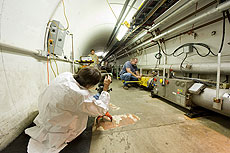Alignment crew members Randy Wyatt, Scott McCormick, and Gary Crutche calibrate newly replaced Tevatron magnet during the 2009 shutdown.
The first particle collisions last week signaled that the Tevatron, the world’s highest-energy proton-antiproton collider, is back in business.
After 11 weeks of maintenance, repairs, upgrades and testing, followed by a
few weeks to bring equipment back on line and cool down, the Accelerator
Division brought the Tevatron back into action. Collisions began last
Wednesday and continue through today, gradually ramping up in luminosity.
“This proved that everything worked,” said Bob Mau, Accelerator Division Operations Department head. “It was the best startup that we ever had.”
During the course of the shutdown, which began June 14, crews of technicians, engineers, and physicists installed 32 Booster corrector magnets, warmed up and fixed leaks in nine Tevatron cryogenic houses, added infrastructure and buildings to house equipment for an upgrade to the Main Injector for future neutrino projects. They replaced six Tevatron magnets and completed many other tasks.
Although he hasn’t compiled all of the statistics yet, John Anderson, Accelerator Division senior safety officer, said crews did an excellent job of getting their work done safely.
“We had a few injuries, but considering the length of the shutdown and the complicated work that we did, I think we did well,” Anderson said. “We also did a lot of planning to keep radiation doses for all workers as low as reasonably achievable, and those doses came in on the initial estimate.”
Although Fermilab has certainly had long shutdowns in the past, this one, involved more work than any previous shutdown. The Accelerator Division welcomed volunteers from other Fermilab sections and divisions and hired contractors to help.
“The shutdown went really well,” Mau said. “The success was largely thanks to employees’ dedicated work and long hours.”
Mau also attributed the shutdown’s success to better planning.
“I remember when shutdowns in the '70s lasted a week or maybe two,” Mau said. “Now there is so much more to do that we have to do a lot more planning and coordination.”
Mau hopes that the work done during this shutdown will help the Tevatron achieve record luminosities during the rest of its run. Whether a shutdown will take place next year has not yet been determined, Mau said.
Accelerator Division employees hope to get the Tevatron back to pre-shutdown luminosities within the next two months.
“Startup is like a train engine,” Mau said. “It takes a little while to get up to steam.”
For out more coverage on the shutdown and start up, check out Quantum Diaries blogs by Ron Moore, Homer Wolfe and Jonathan Assadi.







